
Model of a water bridge from Hadrian's Aqueduct
This section will be enlarged as research continues.
Roman Emperor Hadrian's Aqueduct
Built to supply Ancient Athens with water

Model of a water bridge from Hadrian's Aqueduct
LINKS TO SECTIONS
Surface Channels at the Olympic Village (+ Text)
Underground Tunnels at the Olympic Village
Search for the water source from the Olympic Village
DOWNLOAD List of precise GPS positions of sections of the aqueduct
Background information
The Roman emperor Hadrian, was one the most important admirers of Greece and during his reign many major public works were constructed that have left their mark on the city of Athens. The Hadrian Aqueduct was one such project.
The Hadrian Aqueduct was started in 125 AD on the orders of the emperor and completed fifteen years later (140 AD), during the reign of Antoninus Pius. The aqueduct consisted primarily of a underground tunnel, 25 km. long, which was constructed manually through solid rock by hundreds of slaves using simple tools such as chisels and hammers. The aqueduct was designed not only to transfer water towards the city but also to collect it through a number of smaller catchment works along the way.
One of his aims was to was to serve a new Hadrianic quarter of the city (The City of Hadrian or Hadrianopolis) southeast of the ancient city - which covered current Zappeio, and extended from Kalimarmaro up to the Parliament building.
The Hadrian Aqueduct began at the foot of Mount Parnitha in the area of Tatoi, collected more water from Kifissia and transported it by gravity to a stone reservoir on the hill of Lycabettus in the city of Athens. This reservoir was referred to a Hadrian’s Reservoir ((dimensions 26.10 x 9.10m and 2m deep) and had an initial storage capacity of almost 500 cubic meters of water.
The Romans used to manufacture cisterns near the sources, in most of their aqueducts. In this way, the principle of communicating vessels was in force and, consequently, they maintained constant flow and pressure in their aqueducts. The transportation of water was realized using the so-called vaulted departments which, with a 1:1000 gradient, ensured constant flow.
The Hadrianian aqueduct transected the present-day municipalities of Acharnes, Metamorphosis, Maroussi, N. Ionia, N. Psychico, N. Philadelphia and Ambelokipi.
The aqueduct consisted of channels, tunnels (large sections carved through solid rock), and water bridges.
The underground tunnel sections were constructed in rectangular shaped venues with an arched cover, 0.70m width and 1.60m height. At 35m intervals, square or circular cross-section shafts (access points - for cleaning and ventilation) were created.
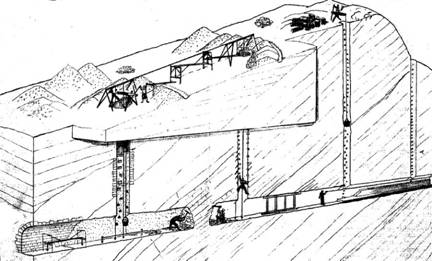
Above: The Roman method of creating aqueduct tunnels.
The earth and rocks were removed
with cranes using baskets on the
end of ropes
lowered down the shafts. The bricks and mortar to line
the tunnel & shafts
were lowered the same way.
Parts of the aqueduct are still preserved in Nea Ionia (2 water bridges - one in Kalogreza and one near the border with Filothie), the Olympic Village (channels & tunnels) and elsewhere including underground sections in Marousi, Halandri, Nea Psychico to depths of up to 20 m.
It is significant that, the aqueduct was made to collect water not only from the
initial source, but also to pick up additional quantities from other sources along the way.
For this reason, branches of the water-carrier, supplementary tunnels or smaller aqueducts
were created. They carried water from other springs around the area of Athens (Halandri,
Kokkinara, Kithara Monomati).
The Hadrian Aqueduct and Reservoir were the main sources of water for the city of Athens in the years that followed. It operated without change until the time of the Turkish Occupation (which began in 1456). From this point on, the Roman aqueduct and reservoir were left to deteriorate.
The retreating Turkish Army destroyed many water supply works during the war for the liberation of Greece (1821). Hence, at the time of Athens’ liberation in 1830, the city’s water supply problem was critical and demanded immediate attention.
The new city authorities commissioned a number of projects to rebuild and renovate existing local water supply works, such as the ancient Hadrian Aqueduct system, as well as the construction of other small-scale water projects. The aqueduct was cleaned of accumulated debris, repaired, and put into operation again in 1840. In 1870 the remains of the Hadrian Reservoir were uncovered and a new reservoir was built in its place with an increased storage capacity of 2.200 cubic meters of water. The new Hadrian reservoir operated up until 1940.However none of the above endeavours provided a real solution to Athens’s water problem. For almost 100 years after the liberation of Athens, the city of Athens continued to depend on wells and other local sources for water.
In the early 1900’s, Athens’ rapidly increasing population called for the city to grow and expand at a similar rate. This rapid development demanded that immediate action be taken regarding water supply. In 1922 with the huge influx of refugees from Asia Minor, Athens underwent a sharp increase in population that had a devastating effect on the city’s water supply.
An American Company by the name ULEN Company was commissioned to renovate and increase the water supply capacity of the Hadrian Aqueduct system, as well as to construct a new water supply system for the Athens and Piraeus area.
Thus in 1925 a contract was signed between the Greek Government, the Bank of Athens and the American Firm ULEN for the financing and construction of the new water supply works. The result of the contract was the formation of a company with the name "The Greek Water Company S.A." (with the acronym EEY), whose sole purpose was to construct and operate water supply works for Athens.
The first major project was the construction of Marathon Dam (1926-1929), with a total height of 54 m. and a length of 285 m. Over 900 people were involved in the construction of the dam, which is considered unique because it is entirely paneled externally with Pentelikon white marble.
The central Athens section of Hadrian's aqueduct
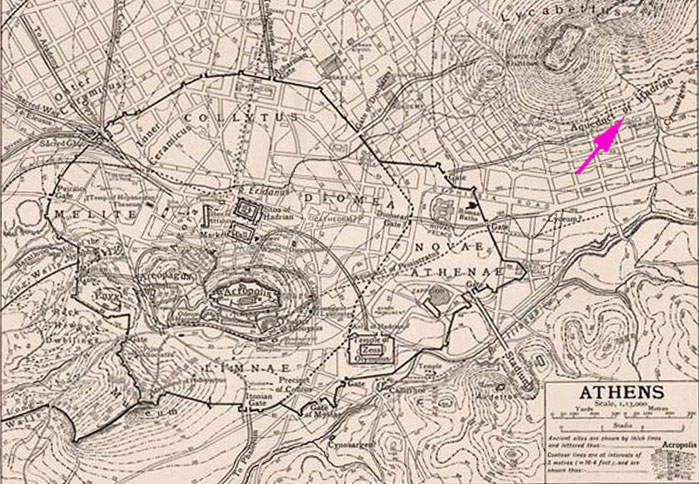
Old map showing the aqueduct terminating at the cistern in Kolonaki on Lycabettus hill
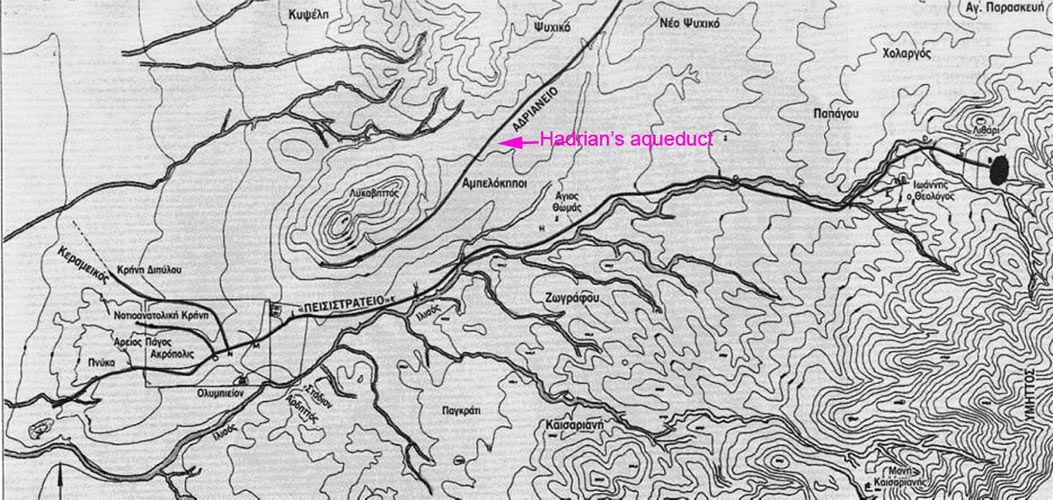
Layout of the ancient Peisistratos and the Hadrian aqueducts in Athens
Showing the Hadrian aqueduct passing through the suburb of Psychico and terminating at the cistern in Kolonaki on Lycabettus hill
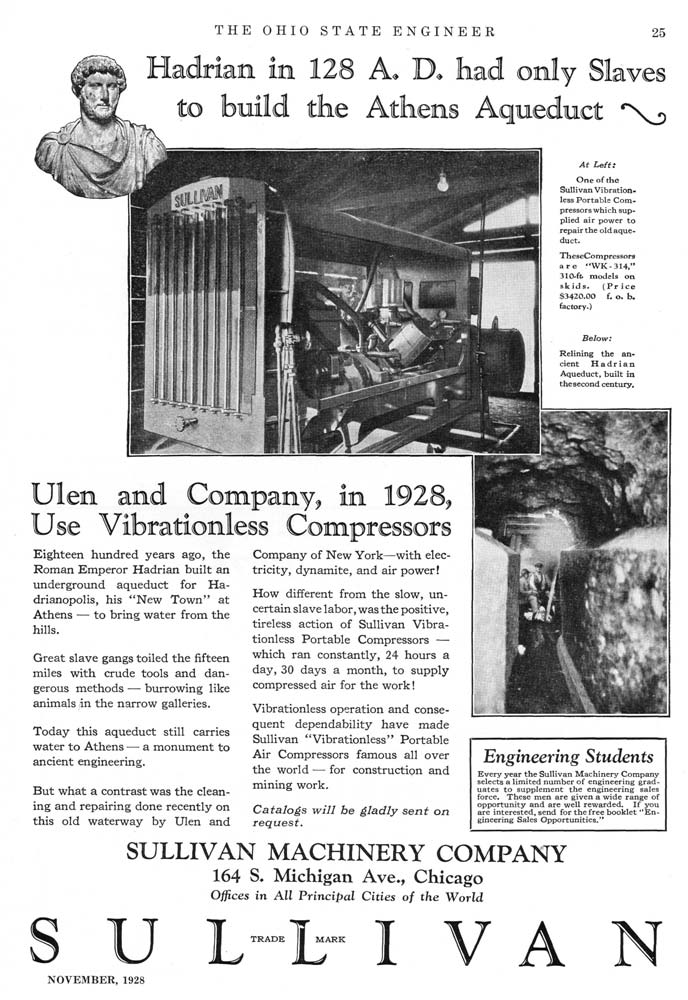
Tunnels

The ULEN construction company of Chicago upgrading
the ancient aqueduct in 1928.
OTHER REFERENCES TO THE AQUEDUCT

Mount Parnitha Teleferique museum - lower section (built by the Hyatt company).
Wall diagram - indicating the water source was from Mount Parnitha.
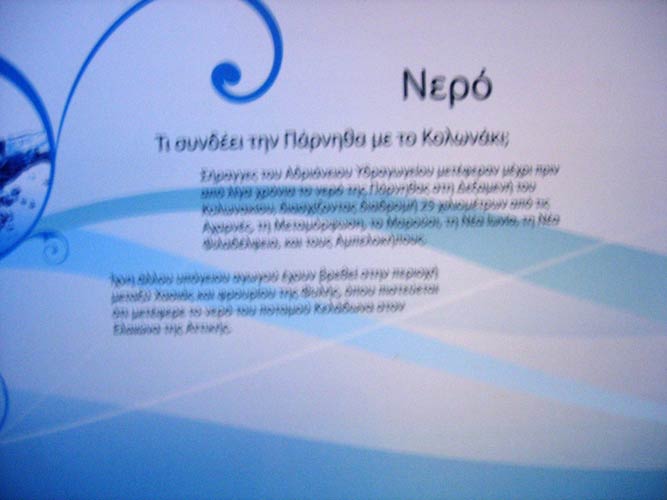
Mount Parnitha Teleferique museum - upper section (built by the Hyatt company).
Wall diagram - indicating the water source was from Mount Parnitha.